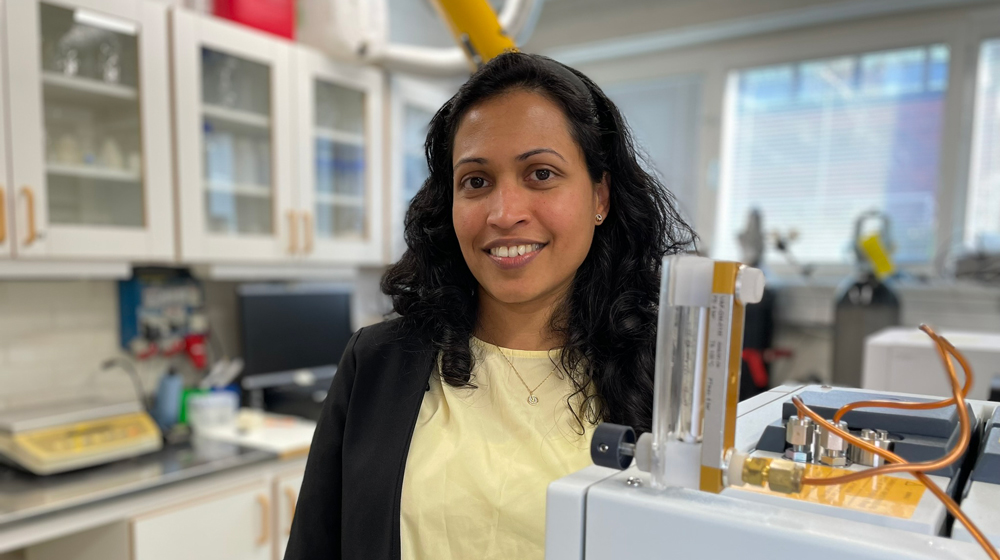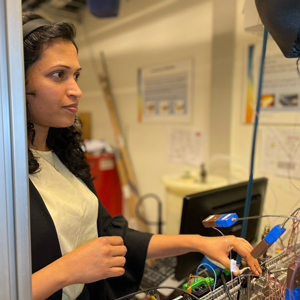Saman wants to save the climate – with flexible energy storage

50 percent of the world's final energy is used in cooling and heating. Yet little attention is paid to the technologies behind it, the role thermal energy storage plays in it, and its connection to electric power. As a new assistant professor at KTH’s department of Energy Technology, Saman wants to change that.
Global warming is about to exceed the 1.5-degree target, while technological progress is constantly advancing. Why so little action in society? I sit down with newly appointed assistant professor Saman Nimali Gunasekara to talk sustainability and energy. We meet in the lab where she proudly shows off a newly installed experimental set-up for thermal energy storage.
"When I say energy storage, what do you think of?" she asks when we sit down to talk.
Batteries, I reply, pointing to the mobile phone in my hand.
"You're not alone," Saman says. “The vast majority see electrification and electricity storage as key strategies to meet climate targets. However, to succeed in the climate battle, we must see beyond, and address the elephant in the room – heating and cooling”.

50 percent of all global final energy use goes to cooling and heating, involving everything from private homes to industries and data centres. In fact, even in northern latitudes, we use a lot of energy to cool down e.g. hospitals, data centres and shopping malls. If we can find a smart way to store heat and cold and link that sector to electric power, we can dramatically reduce global emissions, Saman means. She is exploring how flexible sector coupling between so-called thermal energy and electric power can be designed for different realities – so that heat can be stored when the sun is shining or wind is blowing, and released in the peak hours of the day or even in winter when the electricity is expensive and the demand is high.
“There is a lot of research on energy storage, but the link between different systems and how they can be optimized for different application environments is missing. Here I can contribute with my expertise on thermal energy storage concerning materials, components and systems”.
For instance, a heat pump or a chiller can use cheap, surplus electricity to charge heat or cold into a thermal energy storage. In doing so, one have created a flexible coupling of thermal and electricity sectors that can help minimize renewables curtailment when the power grid is limited.
KTH's Department of Energy Technology has long been strong in heat pumps and their systems. It was its reputation and Sweden's status in sustainability that attracted Saman here fifteen years ago. With a bachelor's degree from University of Moratuwa in Sri Lanka, she applied for a master's degree in sustainable technology at KTH, followed by a PhD and then a postdoc. Now she has recently been appointed assistant professor, but it is not the status she strives for.
"In addition to a larger workload, I also get more formal support to focus on my field. By teaching and supervising students, I believe that we can influence the climate in a positive direction together. We have a lot to learn from each other. At least, that is what drives me”.
Decision-makers need to see the big picture
Saman talks about her desire to continue researching and teaching for the sake of the environment.
“When I read the IPCC's latest report, which stated that we were far behind the global goals, I was extremely moved. I felt that we as scientists had failed to communicate our knowledge and to contribute sufficiently”.
“I wish policy makers would recognize the flexible couplings between thermal energy and electric power and invest in it. We cannot just rely on electrification when heating is such a big part of the problem. We need to look at the large picture”.
And Saman is really pulling her weight. Last autumn, they had a container at KTH where she and her colleagues tested how a technology mix with sorption thermal energy storage could work in different climate conditions, including the Nordics. She is also involved in certain Annexes and Tasks related to thermal energy storage within the Energy Storage technology collaboration program commissioned within the International Energy Agency (IEA).
"It is my duty as a researcher to disseminate as much knowledge as possible to students, other research colleagues and the outside world," says Saman. "I will continue to do so”.
Text and photo: Ulrika Georgsson ulrikage@kth.se
